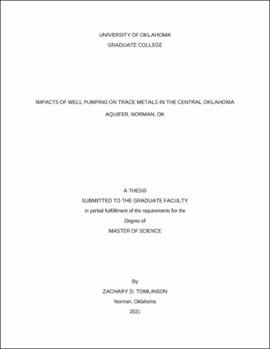| dc.description.abstract | Due to increasing global demand for fresh water, it is increasingly necessary to understand how aquifer pumping affects groundwater chemistry. Water quality may be affected by mobilizing naturally occurring salts or trace metals via water-rock interactions, mixing with deeper saline groundwaters, increased recharge containing anthropogenic inputs, and other site-specific considerations. Comprehensive predictive relationships between pumping and groundwater quality have yet to be developed. Pumping in the Central Oklahoma Aquifer (COA) has increased drastically from the 1980’s, especially around Norman, OK. Studying the changing geochemistry around Norman, OK over the last 40 years in response to changing pumping conditions provides unique insights into how the COA will respond to increased pumping over the next few decades. Data from the City of Norman, the Oklahoma Water Resources Board (OWRB) and the U. S. Geological Survey National Water Information System (NWIS) suggest that changes in pumping rates coincide with sometimes drastic changes in trace metal concentrations, which vary by well, time interval, and how heavily the well is used. The observed trends are most consistent with low pH groundwater flow down wells during inactive periods, a phenomenon already seen in the High Plains Aquifer. This phenomenon can only occur soon after a well has been pumped, while hydraulic gradients facilitate downward flow. If the downward flow (and pH decline) initiated by pumping outweigh the pH increase over the duration of pumping, pH drops overall, leading to trace metal sorption and a decline in trace metal concentrations. If pumping outweighs the effects of the downward flow, pH rises overall and trace metals mobilize. Water volume and pumping frequency also dictate whether inactive periods with downward groundwater flow (producing more negative correlations with pumping) outweigh the active pumping periods (producing more positive correlations with pumping). Inverse modeling in PHREEQC shows that pumping does not significantly affect groundwater chemistry by inducing water mixing/ dilution with a deep Na-Cl brine; it also predicts dolomite dissolution only during modeled time intervals with trace metal decreases and dolomite precipitation only during modeled time intervals with trace metal increases. Lastly, this thesis uses the identified correlations and PHREEQC trends to construct hazard maps of locations most and least likely to see degrading water quality in response to pumping. | en_US |

